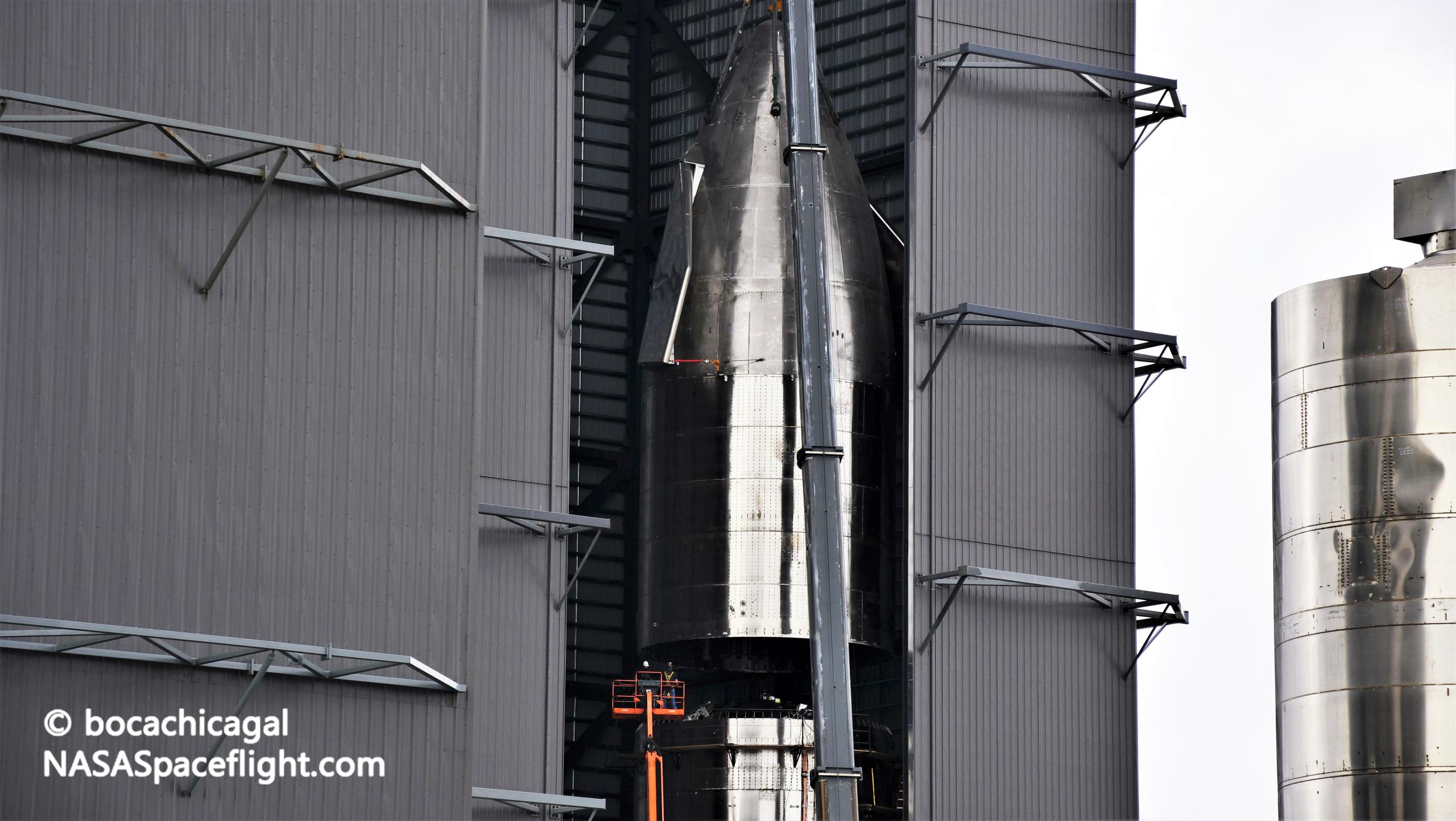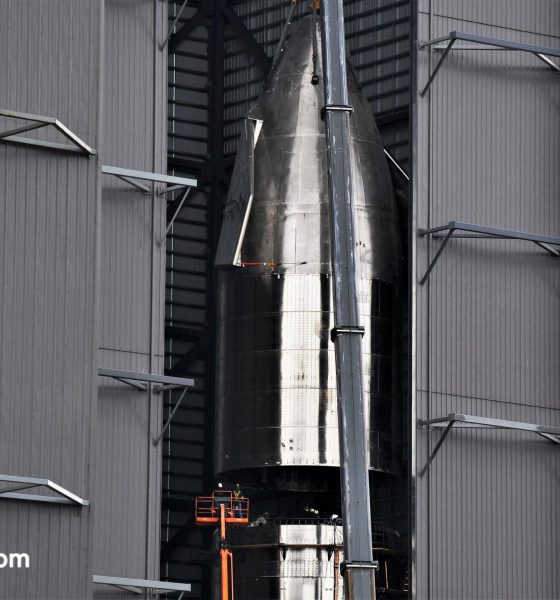

News
SpaceX backup Starship reaches full height after nosecone installation
SpaceX has installed another Starship’s nosecone, all but completing the second full-size prototype a matter of days before the first fully-assembled Starship’s risky launch debut.
Over the last two months, SpaceX has effectively put Starship number 8 (SN8) through an almost nonstop series of tests, completing at least four separate cryogenic proof tests, four Raptor engine static fires, and much more. The company’s South Texas team have also dodged an array of technical bugs; installed, plumbed, and wired what amounts to ~40% of Starship (the nose section) while fully exposed to the coastal elements; and even narrowly avoided a potentially catastrophic failure.
In spite of the many hurdles thrown up and delays resultant, CEO Elon Musk announced earlier this week that Starship SN8 is scheduled to attempt its 15-kilometer (~50,000 ft) launch debut as early as Monday, November 30th. Musk, however, does not see success as the most probable outcome.

Why, then, push to launch Starship SN8 when, in Musk’s own words, the probability of success is as low as “33%”? As previously discussed many times in the history of Teslarati’s BFR and Starship coverage, SpaceX’s attitude towards technology development is (unfortunately) relatively unique in the aerospace industry. While once a backbone of major parts of NASA’s Apollo Program moonshot, modern aerospace companies simply do not take risks, instead choosing a systems engineering methodology and waterfall-style development approach, attempting to understand and design out every single problem to ensure success on the first try.
The result: extremely predictable, conservative solutions that take huge sums of money and time to field but yield excellent reliability and all but guarantee moderate success. SpaceX, on the other hand, borrows from early US and German rocket groups and, more recently, software companies to end up with a development approach that prioritizes efficiency, speed, and extensive testing, forever pushing the envelope and thus continually improving whatever is built.
In the early stages of any program, the results of that approach can look extremely unusual and rudimentary without context (i.e. Starhopper, above), but building and testing a minimum viable product or prototype is a very intentional foundation. Particularly at the start, those minimal prototypes are extremely cheap and almost singularly focused on narrowing a vast range of design options to something more palatable. As those prototypes rapidly teach their builders what the right and wrong questions and design decisions are, more focused and refined prototypes are simultaneously built and tested.
Done well, the agile approach is often quite similar to evolution, where prototype failures inform necessary design changes and killing off dead-end strategies, designs, and assumptions before they can be built upon. In many cases, compared to cautious waterfall-style development, it will even produce results that are both better, cheaper, and faster to realize. SpaceX’s Starship program is perhaps the most visible example in history, made all the more interesting and controversial by the fact that it’s still somewhere in between its early, chaotic development phase and a clear path to a viable product.
On the build side of things, SpaceX has created a truly incredible ad hoc factory from next to nothing, succeeding to the point that the company is now arguably testing and pushing the envelope too slowly. As of November 2020, no fewer than eight full-size Starships and the first Super Heavy booster prototype are visibly under construction. Most recently, Starship SN9 was stacked to its full height, kicking off nosecone installation while still at the build site (unlike SN8). SN10’s completed tank section is likely ready to begin flap installation within the next few days, while Starship SN11 is perhaps a week or two behind that. Additionally, large tank sections of Starships SN12, SN13, SN14, SN15, and (most likely) SN16 are already completed and have all been spotted in the last few weeks.
Some ~90% of the above work was likely started after Starship SN8 first left the factory and rolled to the launch pad on September 26th. In many regards, SN8 has been the first to reach multiple major milestones, largely explaining the relatively plodding pace of its test program compared to SN4, SN5, and SN6.


Ultimately, SN9’s imminent completion – effectively a superior, more refined copy of SN8 – means that Starship SN8’s utility to SpaceX is rapidly deteriorating. The company would almost assuredly never skip an opportunity to learn, meaning that there’s no plausible future in which SN8 testing doesn’t continue, but that doesn’t mean that SpaceX can’t turn its risk tolerance to 11. In essence, accept a 67% (or higher) chance of Starship SN8’s violent destruction but learn as much as possible in the process. As long as good data is gathered, SN8’s launch debut will be a success for Starship whether the rocket lands in one or several pieces.

News
Tesla FSD fleet is nearing 7 billion total miles, including 2.5 billion city miles
As can be seen on Tesla’s official FSD webpage, vehicles equipped with the system have now navigated over 6.99 billion miles.

Tesla’s Full Self-Driving (Supervised) fleet is closing in on almost 7 billion total miles driven, as per data posted by the company on its official FSD webpage.
These figures hint at the massive scale of data fueling Tesla’s rapid FSD improvements, which have been quite notable as of late.
FSD mileage milestones
As can be seen on Tesla’s official FSD webpage, vehicles equipped with the system have now navigated over 6.99 billion miles. Tesla owner and avid FSD tester Whole Mars Catalog also shared a screenshot indicating that from the nearly 7 billion miles traveled by the FSD fleet, more than 2.5 billion miles were driven inside cities.
City miles are particularly valuable for complex urban scenarios like unprotected turns, pedestrian interactions, and traffic lights. This is also the difference-maker for FSD, as only complex solutions, such as Waymo’s self-driving taxis, operate similarly on inner-city streets. And even then, incidents such as the San Francisco blackouts have proven challenging for sensor-rich vehicles like Waymos.
Tesla’s data edge
Tesla has a number of advantages in the autonomous vehicle sector, one of which is the size of its fleet and the number of vehicles training FSD on real-world roads. Tesla’s nearly 7 billion FSD miles then allow the company to roll out updates that make its vehicles behave like they are being driven by experienced drivers, even if they are operating on their own.
So notable are Tesla’s improvements to FSD that NVIDIA Director of Robotics Jim Fan, after experiencing FSD v14, noted that the system is the first AI that passes what he described as a “Physical Turing Test.”
“Despite knowing exactly how robot learning works, I still find it magical watching the steering wheel turn by itself. First it feels surreal, next it becomes routine. Then, like the smartphone, taking it away actively hurts. This is how humanity gets rewired and glued to god-like technologies,” Fan wrote in a post on X.
News
Tesla starts showing how FSD will change lives in Europe
Local officials tested the system on narrow country roads and were impressed by FSD’s smooth, human-like driving, with some calling the service a game-changer for everyday life in areas that are far from urban centers.

Tesla has launched Europe’s first public shuttle service using Full Self-Driving (Supervised) in the rural Eifelkreis Bitburg-Prüm region of Germany, demonstrating how the technology can restore independence and mobility for people who struggle with limited transport options.
Local officials tested the system on narrow country roads and were impressed by FSD’s smooth, human-like driving, with some calling the service a game-changer for everyday life in areas that are far from urban centers.
Officials see real impact on rural residents
Arzfeld Mayor Johannes Kuhl and District Administrator Andreas Kruppert personally tested the Tesla shuttle service. This allowed them to see just how well FSD navigated winding lanes and rural roads confidently. Kruppert said, “Autonomous driving sounds like science fiction to many, but we simply see here that it works totally well in rural regions too.” Kuhl, for his part, also noted that FSD “feels like a very experienced driver.”
The pilot complements the area’s “Citizen Bus” program, which provides on-demand rides for elderly residents who can no longer drive themselves. Tesla Europe shared a video of a demonstration of the service, highlighting how FSD gives people their freedom back, even in places where public transport is not as prevalent.
What the Ministry for Economic Affairs and Transport says
Rhineland-Palatinate’s Minister Daniela Schmitt supported the project, praising the collaboration that made this “first of its kind in Europe” possible. As per the ministry, the rural rollout for the service shows FSD’s potential beyond major cities, and it delivers tangible benefits like grocery runs, doctor visits, and social connections for isolated residents.
“Reliable and flexible mobility is especially vital in rural areas. With the launch of a shuttle service using self-driving vehicles (FSD supervised) by Tesla in the Eifelkreis Bitburg-Prüm, an innovative pilot project is now getting underway that complements local community bus services. It is the first project of its kind in Europe.
“The result is a real gain for rural mobility: greater accessibility, more flexibility and tangible benefits for everyday life. A strong signal for innovation, cooperation and future-oriented mobility beyond urban centers,” the ministry wrote in a LinkedIn post.
News
Tesla China quietly posts Robotaxi-related job listing
Tesla China is currently seeking a Low Voltage Electrical Engineer to work on circuit board design for the company’s autonomous vehicles.

Tesla has posted a new job listing in Shanghai explicitly tied to its Robotaxi program, fueling speculation that the company is preparing to launch its dedicated autonomous ride-hailing service in China.
As noted in the listing, Tesla China is currently seeking a Low Voltage Electrical Engineer to work on circuit board design for the company’s autonomous vehicles.
Robotaxi-specific role
The listing, which was shared on social media platform X by industry watcher @tslaming, suggested that Tesla China is looking to fill the role urgently. The job listing itself specifically mentions that the person hired for the role will be working on the Low Voltage Hardware team, which would design the circuit boards that would serve as the nervous system of the Robotaxi.
Key tasks for the role, as indicated in the job listing, include collaboration with PCB layout, firmware, mechanical, program management, and validation teams, among other responsibilities. The role is based in Shanghai.
China Robotaxi launch
China represents a massive potential market for robotaxis, with its dense urban centers and supportive policies in select cities. Tesla has limited permission to roll out FSD in the country, though despite this, its vehicles have been hailed as among the best in the market when it comes to autonomous features. So far, at least, it appears that China supports Tesla’s FSD and Robotaxi rollout.
This was hinted at in November, when Tesla brought the Cybercab to the 8th China International Import Expo (CIIE) in Shanghai, marking the first time that the autonomous two-seater was brought to the Asia-Pacific region. The vehicle, despite not having a release date in China, received a significant amount of interest among the event’s attendees.








